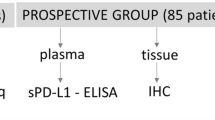Abstract
Purpose
CD44 is a cell surface glycoprotein involved in cell–cell and cell–substrate interactions, which may be shed or released into circulation by proteolytic enzymatic mechanisms. Alternative splicing of CD44 and aberrant levels of soluble CD44 variants in the serum of cancer patients have been correlated to tumor progression and metastasis in different tumors including breast cancer. In this study we evaluated the clinical value of CD44 serum levels (sCD44) in patients with primary breast cancer.
Methods
Concentrations of soluble isoforms sCD44std, sCD44v5 and sCD44v6 were determined with a sensitive ELISA and normalized against the total protein concentration (TP). Pre-operative serum samples from 82 patients and 67 age-matched healthy blood donors were analyzed. The results were correlated to clinico-pathological parameters (tumor size, grading, lymph node metastasis, etc.).
Results
In sera of breast cancer patients, we detected elevated concentrations of sCD44v6 (P = 0.0001) and total protein TP (P = 0.0001) in comparison to healthy controls, whereas overall sCD44 (sCD44std) and sCD44v5 did not differ. Patients with sCD44v6-concentrations above the 75%-percentile showed an increased T stage (2.9 cm vs. 1.8 cm) as well as a higher risk for lymph node metastasis (55% vs. 35%). In breast cancer patients with lymph node metastasis the median value of sCD44v6 was significantly higher (P = 0.025) in comparison to patients without lymph node metastasis and healthy controls.
Conclusions
Our data suggest an upregulated expression of alternatively spliced soluble CD44 isoforms in breast cancer patients. The specific alterations of certain CD44 isoform concentrations (especially sCD44v6) may reflect disturbances of the nuclear splicing machinery in tumor cells. The clinical significance of our findings are underlined by the positive correlation of elevated sCD44v6 concentrations and lymph node metastases (r s = 0.25).




Similar content being viewed by others
Abbreviations
- C I:
-
Control group I
- CD:
-
Cluster of differentiation
- CD44s:
-
CD44 standard
- CD44v:
-
CD44 variant
- ELISA:
-
Enzyme-linked immunosorbent assay
- ER:
-
Estrogen receptor
- FSH:
-
Follicle stimulating hormone
- PR:
-
Progesterone receptor
- r s :
-
Spearman correlation coefficient
- sCD44:
-
Soluble CD44
- TP:
-
Total protein concentration
References
Cichy J, Pure E (2003) The liberation of CD44. J Cell Biol 161(5):839–843
Fichter M et al (1997) Expression of CD44 isoforms in neuroblastoma cells is regulated by PI 3-kinase and protein kinase C. Oncogene 14(23):2817–2824
Friedrichs K et al (1995) CD44 isoforms correlate with cellular differentiation but not with prognosis in human breast cancer. Cancer Res 55(22):5424–5433
Guriec N et al (1996) CD44 exon 6 expression as a possible early prognostic factor in primary node negative breast carcinoma. Clin Exp Metastasis 14(5):434–439
Guriec N et al (1997) CD44 isoforms with exon v6 and metastasis of primary N0M0 breast carcinomas. Breast Cancer Res Treat 44(3):261–268
Kaufmann M et al (1995) CD44 variant exon epitopes in primary breast cancer and length of survival. Lancet 345(8950):615–619
Kawano T et al (2005a) Evaluation of soluble adhesion molecules CD44 (CD44st, CD44v5, CD44v6), ICAM-1, and VCAM-1 as tumor markers in head and neck cancer. Am J Otolaryngol 26(5):308–313
Kawano T et al (2005b) Soluble CD44 standard, CD44 variant 5 and CD44 variant 6 and their relation to staging in head and neck cancer. Acta Otolaryngol 125(4):392–397
Lackner C et al (1998) Soluble CD44 v5 and v6 in serum of patients with breast cancer. Correlation with expression of CD44 v5 and v6 variants in primary tumors and location of distant metastasis. Breast Cancer Res Treat 47(1):29–40
Lockhart MS et al (1999) Evaluation of soluble CD44 in patients with breast and colorectal carcinomas and non-Hodgkin’s lymphoma. Oncol Rep 6(5):1129–1133
Martin S et al (1997) Soluble CD44 splice variants in metastasizing human breast cancer. Int J Cancer 74(4):443–445
Molica S et al (2001) Elevated serum levels of soluble CD44 can identify a subgroup of patients with early B-cell chronic lymphocytic leukemia who are at high risk of disease progression. Cancer 92(4):713–719
Niitsu N, Iijima K (2002) High serum soluble CD44 is correlated with a poor outcome of aggressive non-Hodgkin’s lymphoma. Leuk Res 26(3):241–248
Ponta H, Sherman L, Herrlich PA (2003) CD44: from adhesion molecules to signalling regulators. Nat Rev Mol Cell Biol 4(1):33–45
Remmele W, Schicketanz KH (1993) Immunohistochemical determination of estrogen and progesterone receptor content in human breast cancer. Computer-assisted image analysis (QIC score) vs. subjective grading (IRS). Pathol Res Pract 189(8):862–866
Sanchez Lockhart M et al (2001) Splice variant expression of CD44 in patients with breast and ovarian cancer. Oncol Rep 8(1):145–151
Sheen-Chen SM et al (1999) Evaluation of the prognostic value of serum soluble CD 44 in patients with breast cancer. Cancer Invest 17(8):581–585
Stickeler E et al (2001) The RNA binding protein YB-1 binds A/C-rich exon enhancers and stimulates splicing of the CD44 alternative exon v4. Embo J 20(14):3821–3830
Tempfer C et al (1996) Prognostic value of immunohistochemically detected CD44 isoforms CD44v5, CD44v6 and CD44v7–8 in human breast cancer. Eur J Cancer 32A(11):2023–2025
Acknowledgments
This work was supported by a grant of the Deutsche Krebshilfe to E. S. (No. 107690)
Author information
Authors and Affiliations
Corresponding author
Rights and permissions
About this article
Cite this article
Mayer, S., zur Hausen, A., Watermann, D.O. et al. Increased soluble CD44 concentrations are associated with larger tumor size and lymph node metastasis in breast cancer patients. J Cancer Res Clin Oncol 134, 1229–1235 (2008). https://doi.org/10.1007/s00432-008-0397-z
Received:
Accepted:
Published:
Issue Date:
DOI: https://doi.org/10.1007/s00432-008-0397-z




